Lenin: numbers, data and images of the crimes of the first communist dictator
One of the most aberrant historical myths of the 20th century is to portray Lenin as the "good" dictator of the USSR, and Stalin as the "bad", in an attempt to salvage the former's mandate.
NOTICE: This article contains images that can hurt your sensitivity
The figures of victims of Leninism, from November 1917 to January 1924
- More than a million people murdered for political or religious reasons.
- Between 300,000 and 500,000 Cossacks killed.
- Hundreds of thousands of workers and peasants killed for striking.
- 240,000 killed in the suppression of the Tambov rebellion.
- More than 50,000 white prisoners of war executed.
- Between 3.9 million and 7.75 million deaths from famines among Russians, Kazakhs and Tatars.
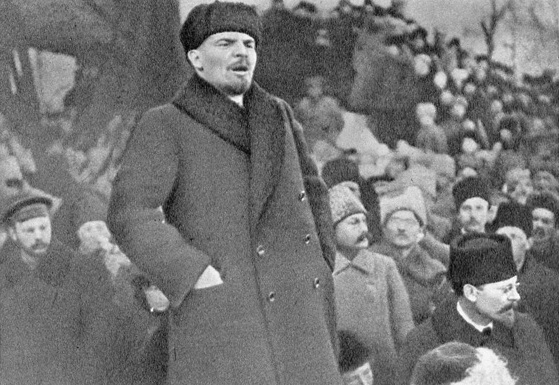
Lenin at a rally on March 18, 1918.
A communist coup d'etat that aborted democracy in Russia
To demystify Lenin one must first break other myths. The most basic is that when the Bolshevik coup d'etat broke out on November 7, 1917, the communists did not overthrow the Tsar - which no longer reigned - but aborted the incipient democracy in Russia, taking advantage of the crisis that arose between conservatives and socialists. After the violent assault on power by the communists, a civil war broke out that lasted five years, and in which - already in power - the Bolsheviks - who were victorious - faced all their rivals. It was the beginning of a bloody dictatorship that would last more than 70 years, until the disappearance of the USSR in 1991.
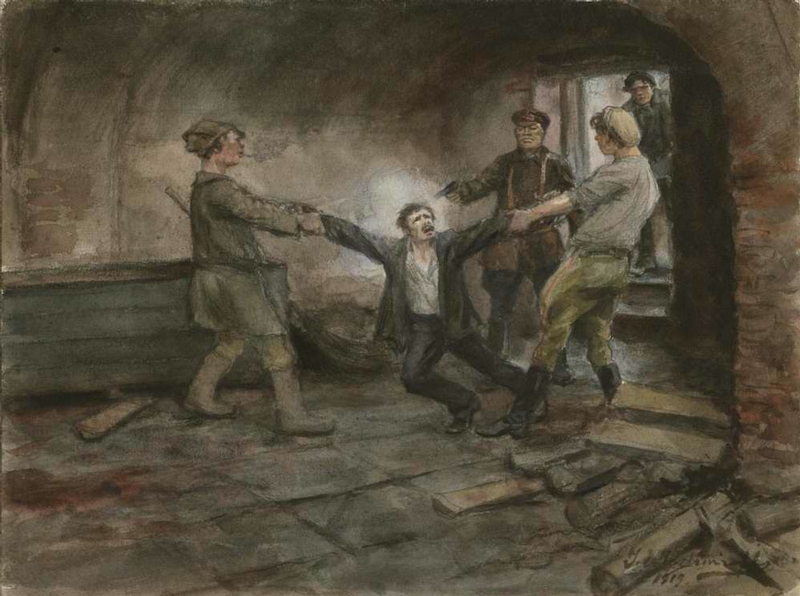
Bolshevik Chekists murdering a detainee, in a work by Lithuanian painter Ivan Vladimirov (1869-1947).
Lenin had already advanced his plans: dictatorship and violent repression
Shortly before that communist revolution, in the summer of 1917 Lenin wrote a book, "The State and Revolution", outlining what his dictatorship would be like. Among other considerations, the future despot tugged at the grossest demagoguery and lashed out at parliamentary democracy:
"Deciding once in a certain number of years which members of the ruling class are to oppress and crush the people in Parliament: this is the true essence of bourgeois parliamentarism, not only in the parliamentary constitutional monarchies, but in the most democratic republics."
Lenin advocated "for the destruction of bourgeois parliamentarism" and "for a Republic of Soviets of workers 'and soldiers' deputies, for the revolutionary dictatorship of the proletariat." That dictatorship would imply "a series of restrictions imposed on the freedom of the oppressors, of the exploiters, of the capitalists" (in the end he would apply them to everyone), and he added: "it is evident that where there is repression there is violence, not there is neither freedom nor democracy." In the book, in addition, he already advanced with absolute frankness and before coming to power that violence would use it "both to crush the resistance of the exploiters and to direct the enormous mass of the population, the peasants, the petty bourgeoisie, to the semi-proletarians, in the work of "starting up" the socialist economy." Years later, one of the closest collaborators of the communist dictator, Leon Trotsky, would write Lenin's words to those who were reluctant to use terrorism: "Do you really believe that we can be victorious without using the most ruthless terror?"
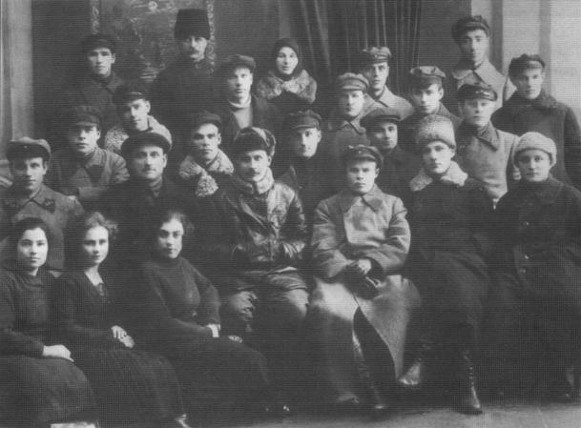
Officials of the Cheka de Uman in 1920.
In three years Lenin multiplied by 18 the repressive apparatus of tsarism
As soon as the communists took power, they began to organize their repressive apparatus. One of the first measures of the Bolshevik dictatorship was to establish the Chrezvycháinaya Komíssiya (better known as Cheka), a political police force founded on December 20, 1917, when Lenin had been a dictator for more than a month as "President of the Council of People's Commissars". The tsarist secret police, the fearsome Okhrana, had grown to have some 15,000 members, charged with arresting political enemies, imprisoning, torturing and even executing them without a court order. At the end of 1918 the Cheka already had 40,000 agents, and two years later there were already 280,000 Chekists. In three years the Bolsheviks had multiplied by 18 the volume of the repressive apparatus of Tsarism.
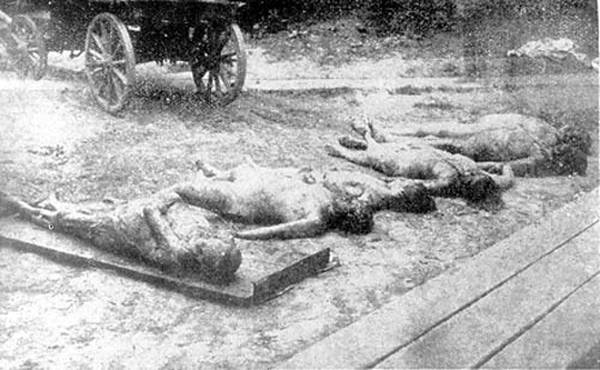
Women killed by Cheka from Kharkiv, Ukraine. Still alive, the Chekists cut their breasts and burned their genitals, putting coals inside.
Cheka's perverse methods of torture and murder
If the Okhrana had been characterized by its brutal methods, the communist Cheka exceeded in every way the degree of cruelty of its tsarist predecessor. Among its methods of torture and assassination against political dissidents, Orthodox clerics and others considered enemies by the Bolsheviks, it is worth mentioning savages such as the following, documented by the Russian historian Alexander Nikolaevich Yakovlev and by the State Archives of the Russian Federation, among others sources:
- Stoning, that is, stoning the prisoner to death.
- Crucifixions, a method used against many priests and religious.
- Strangulations.
- Throw inmates into cauldrons of boiling pitch.
- Drowning of inmates in icy waters.
- Rip off the scalp of inmates. A practice that was done, for example, in the Cheka of Kharkiv, in Ukraine.
- Hanging.
- Force inmates to ingest molten lead.
- Impalement.
- Kill the inmates by throwing them into blast furnaces.
- Castrations.
- Burying inmates alive, a practice perpetrated in the Cheka of Kremenchuk.
- Skinning, that is, tearing off the skin of inmates. The Cheka in Kharkiv used the ripped skin of prisoners to make gloves.
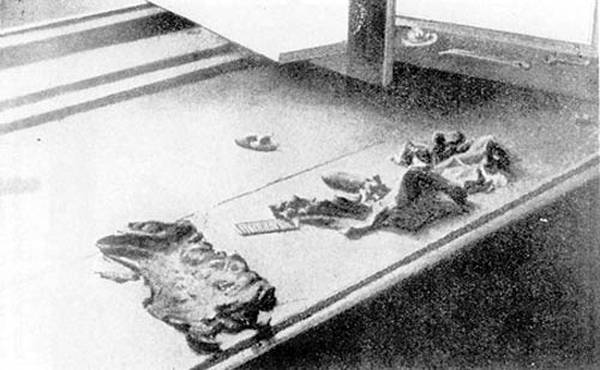
Skin scratched from the hands of detainees in the Cheka basement in Kharkiv, Ukraine. Chekists used metal combs and tongs to apply this horrendous torture.
- Poaching the prisoner, that is, throwing boiling water at him until he is killed.
- Decapitations.
- Stripping inmates, tying them and throwing cold water in the middle of winter until freezing them, a practice of the Cheka de Orel, 360 km from Moscow.
- Killing inmates by throwing them handcuffed into the sea or into a river (this is what the Cheka of Kholmogory in the Dvina River periodically did with her prisoners).
- Tying naked victims around barrels surrounded by nails, and rolling them until the prisoners died, a practice of the Cheka of Voronezh.
- Tying rat cages to prisoners' bodies and rodent rodents with red-hot irons until they made their way through the intestines of prisoners, a practice used by the Kiev Cheka and that years later would include George Orwell in his famous novel "1984".
More than a million people were killed for political or religious reasons during what is known as the Red Terror, between 1918 and 1922, the harshest time of Lenin's dictatorship. To give us an idea, according to the British historian Hugh Thomas, the victims of the Francoist repression number about 100,000 people, among those killed during the Spanish Civil War and the post-war repression. In other words, in just over six years of dictatorship, Lenin murdered ten times more people than is attributed to the Franco dictatorship in almost 40 years.
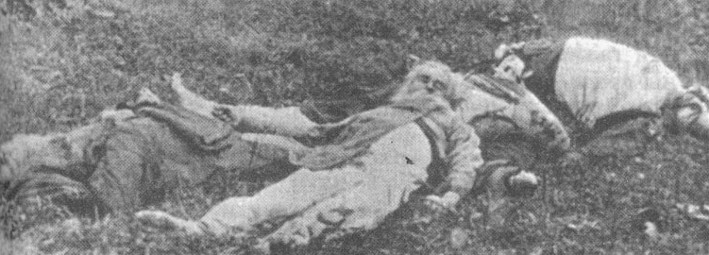
Orthodox monks killed by Cheka in 1919.
The wild persecution against Christians and other religions
With the Bolshevik Revolution of 1917 a systematic religious persecution began which would, throughout the history of the USSR, involve the murder of between 12 and 20 million Christians. In 1914 the Russian Orthodox Church had 55,173 churches, 29,593 chapels, 550 monasteries and 475 convents: the vast majority of them were closed and destroyed by the Communists. Something similar happened with the 5,000 Jewish synagogues and the 25,000 Muslim mosques that were in Russian territory in 1917. Before the Revolution there were also 112,629 priests and deacons and 95,259 monks and nuns of the Orthodox Church. The Communists unleashed brutal persecution against them. According to Yakovlev, some 3,000 priests, religious and nuns were already killed in 1918 alone with methods as brutal as those mentioned above. Many lay people were harassed, tortured, detained and killed. Historian Dimitry V. Pospielovsky reported the Reds' brutality against priests with cases such as the following:
- An 80-year-old priest named Amvrosi was brutally beaten with his butt before being killed.
- Another priest named Dimitri was taken to a cemetery and stripped naked, and when he tried to cross himself before being killed, a Bolshevik cut off his right arm.
- Another old priest who was trying to stop the execution of a peasant was beaten, murdered, and dismembered with the sword by the Bolsheviks. This way of disposing of the corpses was not an isolated case among the Bolshevik crimes against the Orthodox clergy.
- In the Monastery of San Salvador the reds killed the 75-year-old abbot, poaching and beheading him.
- Hermogenes, Archbishop of Tobolsk and Siberia, was tied to the head with stones and thrown into the Tura River, where he drowned.
- In Voronezh seven nuns were killed by boiling them in a cauldron of tar.
- In Pechora, an elderly priest named Rasputin was tied to a telegraph pole, shot dead, and his body was handed over to the dogs for devouring.
In May 1920 Lenin ordered the mass execution of all priests who were against Communism: between 14,000 and 20,000 were killed.
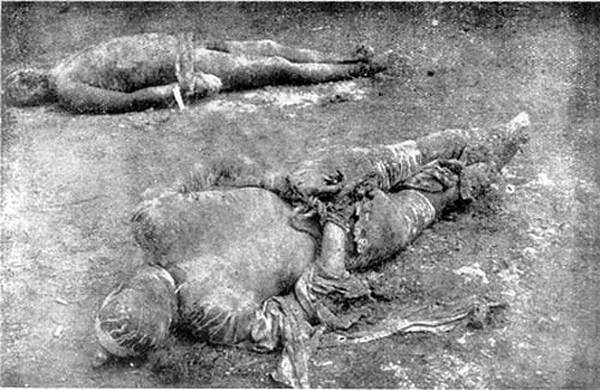
Farmers I. Afanasyuk and S. Prokopovich, handcuffed and skinned alive in a Cheka in Ukraine.
Repression of Kulak farmers
In the summer of 1918 the Bolsheviks faced a rebellion by the Kulaks, peasants from Ukraine and the Caucasus, who owned their own land and opposed Communist collectivization policies and the massive confiscation of their grain productions. Lenin sent a written order to the Penza Bolsheviks to publicly hang at least 100 renowned kulaks, to use as a lesson against the others, and to take hostages to force the others to submit to the Communists. In another order Lenin was even clearer: "A dictatorial troika (yourself, Markin and one other) must be formed immediately, implant mass terror, shoot or deport the hundreds of prostitutes who make soldiers drink, all the former officers, etc. There is not a minute to lose."
The murder of thousands of Red Army deserters and their families
The Red Army suffered 3 million defections in 1919 and 1920. The first year, 500,000 deserters were arrested by the Cheka, and almost 800,000 the second. Thousands of them were killed, and their families were often taken hostage and killed to blackmail deserters. A typical Cheka report stated the following:
"Yaroslavl Province, June 23, 1919. The uprising of deserters on the Petropavlovskaya volost has been quelled. The families of the deserters have been taken hostage. When we started shooting at one person in each family, the Greens started to come out of the woods and surrendered. Thirty-four deserters were shot as an example."
Between August 1920 and June 1921 there was a great anti-Bolshevik rebellion in Tambov with the support of deserters from the Red Army, caused by the massive requisitions ordered by the Communists. The rebels assembled an army of about 40,000 men. The Bolsheviks crushed the rebellion. Between the mass executions and the internments in the Gulag, 240,000 civilians died.
The brutal repression of the Cossacks
Another group that suffered brutal communist repression were the Cossacks, an ethnic group of Turkish origin. Many of its members fought in the White Army, along with the Tsarists, in the Russian Civil War. Between 1918 and 1919 they came to form an independent, democratic Republic. The Bolsheviks directed a harsh repression against them. Historian Michael Kort has estimated that between 300,000 and 500,000 Cossacks were killed in 1919 and 1920, out of a population of 1.5 million.
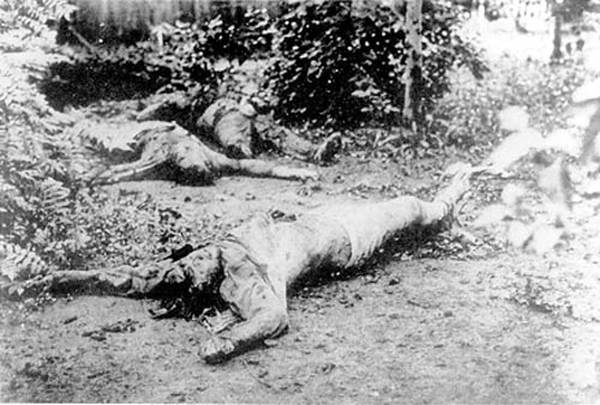
In the foreground, the body of the telegraph operator Ponomarenko in the Cheka of Kharkiv, Ukraine. They cut off his right hand and shows deep cuts on his head. In the background are the bodies of two other victims of the Chekists.
Lenin's creation of a network of concentration camps: the Gulag
In April 1919 Lenin signed a decree to create a concentration camp system copied by the Tsarist Katorga, which in 1916 numbered almost 20,000 inmates, according to figures published by Stephen G. Wheatcroft. The new network of concentration camps was named Glávnoie upravlenie ispravítelno-trudovyj lagueréi i koloni (Directorate-General for Labor Camps). It was the birth of the Gulag, the largest Soviet system of repression. The first of those camps had been established in 1918 at Solovki, on the Solovetsky islands of the Black Sea. Again the figures of the communist dictatorship ended up far exceeding those of tsarism in a short time: at the end of 1920 there were already 84 camps with some 50,000 political prisoners. In October 1923 there were already 315 camps with 70,000 prisoners. Those detained there were used in forced labor as slave labor. The prison population had very high death rates, due to the harsh conditions in these brutal detention centers, where prisoners were often starved or killed by their guardians.
Lenin encouraged mass execution of strikers
The strikes were also bloodied down. On March 16, 1919, Cheka stormed the Putilov factory, where its workers had gone on strike six days earlier, accusing the Bolshevik government of having become a dictatorship: 900 workers were arrested, and 200 executed without trial. Violent repression, imprisonment, hostage-taking and mass murder were the methods most used by the Bolsheviks to quell these strikes, both in the factories and in the fields. On January 29, 1920, in the face of strikes by workers in the Urals region, Lenin sent a telegram to Vladimir Smirnov encouraging the use of mass murder against strikers: "I am surprised that you take the matter so lightly and do not immediately execute a large number of strikers for the crime of sabotage." These methods were even used to quell the protests of workers when they were forced to work on Sunday, as happened in Tula, a malaise that the Bolsheviks simply attributed to a "counter-revolutionary conspiracy forged by Polish spies." It is estimated that hundreds of thousands of rebel workers and peasants were executed between 1918 and 1922.
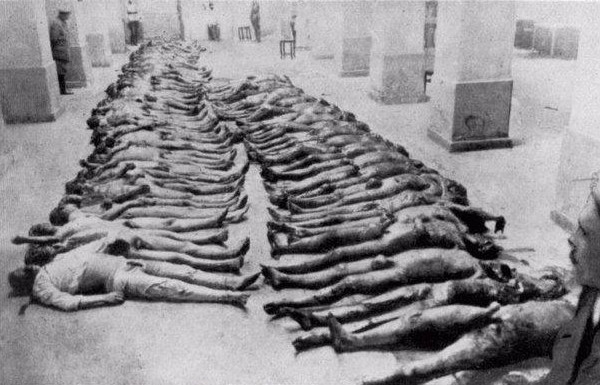
Killed by Cheka from Kiev, Ukraine, in 1919.
The mass execution of prisoners of war
In the late 1920s Lenin approved of the mass murder of 50,000 "white" and civilian prisoners in Crimea, shot or by hanging, in one of the largest massacres of the Russian Civil War. The victims of this crime had surrendered, according to Robert Gellately, after the Bolshevik promise that there would be an amnesty for them if they surrendered.
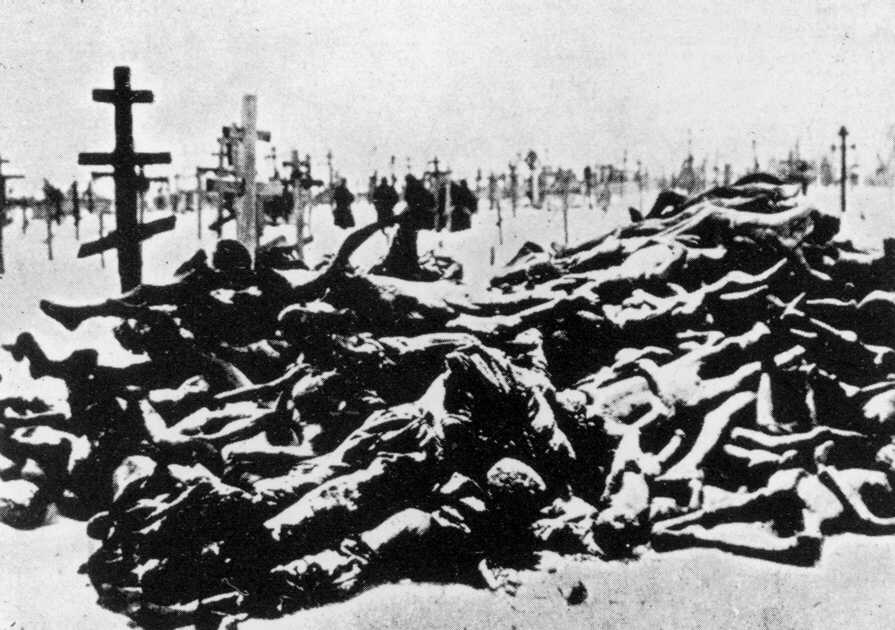
The stacked corpses of victims of the Russian famine in Buzuluk, in the Volga region, winter from 1921 to 1922.
Lenin used hunger for political purposes: from 3.9 million to 7.75 million dead
One of the most dramatic episodes of Lenin's dictatorship was the Russian famine of 1921 and 1922, which affected some 27 million people and killed between 3 and 5 million, and which was caused, in large part, by the mass requisitions of grain ordered by the Bolsheviks, the so-called Prodrazvyorstka (copied and expanded by the Communists, like other things, from the Razvyorstka, the requisition of tsarist grain in the First World War). The requisitioned grain was often used for export. This extermination through hunger was not accidental or that the Bolshevik dictatorship tried to avoid: it was done intentionally and even sought with it an anti-religious purpose, as Lenin wrote in a letter from Lenin to the Politburo on March 19, 1922:
"Now and only now, when people consume themselves in famine-stricken areas and hundreds, if not thousands, of corpses lie on the roads, we can (and therefore must) pursue the removal of church property with the most energy frenzied and ruthless and do not hesitate to quell the least opposition. (...) We must pursue the elimination of church property by any means necessary to secure a fund of several hundred million gold rubles (do not forget the immense wealth of some monasteries and lauras). (...) All considerations indicate that we will not do it later, because at no other time, apart from desperate hunger, will it give us that state of mind among the general mass of peasants that would guarantee the sympathy of this group, or, at least , would assure us the neutralization of this group in the sense that victory in the fight for the elimination of church property, unquestionably and completely, will be on our side."
This use of famines as a method of achieving political objectives had already been advanced by Lenin in 1891, when he refused to collaborate with a campaign to help the hungry in the city of Samara. According to Lenin, hunger has "numerous positive consequences", since "it destroys not only faith in the Tsar, but also in God" (quoted by Stéphane Courtois, Nicolas Werth, Jean-Louis Panné, Andrzej Paczkowski, Karel Bartosek and Jean-Louis Margolin in "Le livre noir du communisme", 1997).
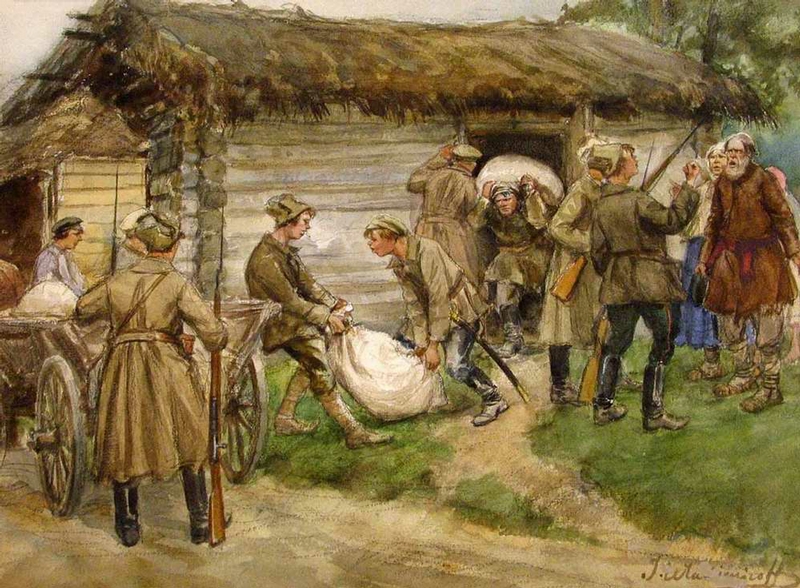
Bolsheviks seizing grain from peasants, in a work by the Lithuanian painter Ivan Vladimirov (1869-1947). These searches caused great discontent and were, to a large extent, the cause of the lethal famine of 1921 and 1922.
The Russian famine was not the only one in the territory of the USSR during the Lenin dictatorship. Similar famines were suffered by the Kazakhs (1919–1922, between 400,000 and 750,000 dead) and the Tatars (1921-1922, between 500,000 and 2 million dead), all of them under Soviet rule. Adding these figures to those of the Russian famine, we have between 3.9 million and 7.75 million deaths due to hunger, a situation caused, I insist, by the communist regime itself.
Famines and appalling living conditions led to rebellions in the USSR, today little remembered by most of the world. One of the most significant, in addition to that of Tambov, was that of Kronstadt in March 1921, when civilians, soldiers and sailors of the Baltic Soviet fleet rose up against the Bolsheviks. The Red Army put down the rebellion by executing thousands of people.
|
Don't miss the news and content that interest you. Receive the free daily newsletter in your email: Click here to subscribe |
- Most read
- The Pegasus case and how it could end with Pedro Sánchez due to a decision by France
- The real reason for Sánchez's victimizing letter using his wife as an excuse
- The brutal 'touch and go' of a Lufthansa Boeing 747 at Los Angeles Airport
- What did Morocco find in Pedro Sánchez's cell phone to humiliate him in this way?
- The Spanish left launches a hunt against three things that distinguish us from a dictatorship
- The ten oldest national flags in the world that are still in use today
- The massive takeoff of more than half of the United States B-2 Spirit stealth bombers
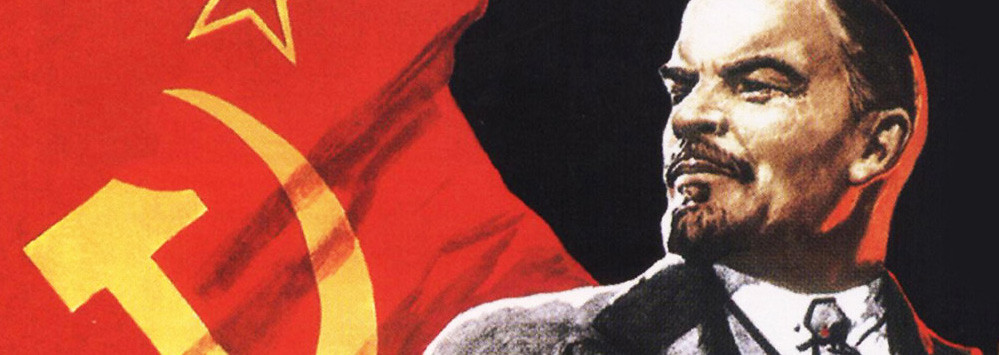
 ES
ES

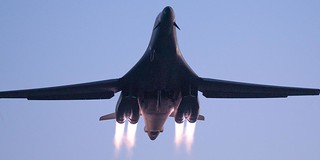



Opina sobre esta entrada: